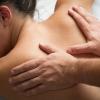CYBERMED LIFE - ORGANIC & NATURAL LIVING
CYBERMED LIFE - ORGANIC & NATURAL LIVING
 Massage Therapeutic Touch: Massage is to work and act on the body with pressure. Massage techniques are commonly applied with hands, fingers, elbows, knees, forearm, feet, or a device. The purpose of massage is generally for the treatment of body stress or pain. People who are professionally trained to give massages were traditionally known as masseurs or masseuses, but the term massage therapist has been promoted.
Massage Therapeutic Touch: Massage is to work and act on the body with pressure. Massage techniques are commonly applied with hands, fingers, elbows, knees, forearm, feet, or a device. The purpose of massage is generally for the treatment of body stress or pain. People who are professionally trained to give massages were traditionally known as masseurs or masseuses, but the term massage therapist has been promoted.
In professional settings, clients are treated while lying on a massage table, sitting in a massage chair, or lying on a mat on the floor. In amateur settings, a general purpose surface like a bed or the floor is more common. Aquatic massage and bodywork is performed with recipients submersed or floating in a warm-water therapy pool.
The main professionals that provide therapeutic massage are massage therapists, athletic trainers, physical therapists and practitioners of many traditional Chinese and other eastern medicines. Massage practitioners work in a variety of medical settings and may travel to private residences or businesses. Contraindications to massage include deep vein thrombosis, bleeding disorders or taking blood thinners such as Warfarin, damaged blood vessels, weakened bones from cancer, osteoporosis, or fractures, bruising, and fever.
Peer-reviewed medical research has shown that the benefits of massage include pain relief, reduced trait anxiety and depression, and temporarily reduced blood pressure, heart rate, and state of anxiety. Additional testing has shown an immediate increase and expedited recovery periods for muscle performance. Theories behind what massage might do include blocking nociception (gate control theory), activating the parasympathetic nervous system, which may stimulate the release of endorphins and serotonin, preventing fibrosis or scar tissue, increasing the flow of lymph, and improving sleep, but such effects are yet to be supported by well-designed clinical studies.
Massage is hindered from reaching the gold standard of scientific research, which includes placebo-controlled and double blind clinical trials. Developing a "sham" manual therapy for massage would be difficult since even light touch massage could not be assumed to be completely devoid of effects on the subject. It would also be difficult to find a subject that would not notice that they were getting less of a massage, and it would be impossible to blind the therapist. Massage can employ randomized controlled trials, which are published in peer reviewed medical journals. This type of study could increase the credibility of the profession because it displays that purported therapeutic effects are reproducible.